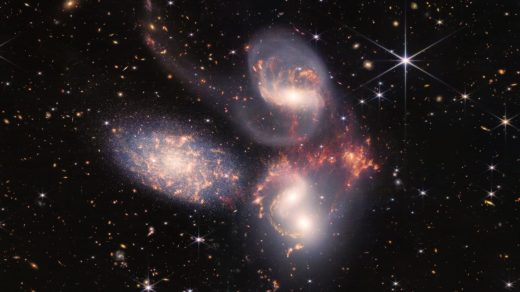Simulations reveal the hidden behaviors of dark matter
By Rachael Zisk
With everything we learn about the nature of dark matter—that mysterious, unseeable substance that helps galaxies to form—there are a hundred new questions to answer. A new theory about how dark matter interacts with gasses just hit the wire, and it’s leading scientists down a new path of cosmological discovery.
In a study published Wednesday in The Astrophysical Journal Letters, a team of UCLA researchers created a simulation of how dark matter may have behaved in the early universe. The new concept shows that colder dark matter moved at relatively slow velocities, while standard matter streamed past it at supersonic relative speeds. This would have given rise to very small, brightly burning galaxies earlier in the universe’s history than current theories suggest.
“The discovery of patches of small, bright galaxies in the early universe would confirm that we are on the right track with the cold dark matter model because only the velocity between two kinds of matter can produce the type of galaxy we’re looking for,” Smadar Naoz, a UCLA physics and astronomy professor and an author of the study, said in a release.
Dark matter
How do you measure something you can’t see? Dark matter, though it makes up an estimated 27% of the universe, can’t be observed with our optical telescopes or electrical or magnetic field sensors. Astronomers have never actually detected it directly.
It does, however, interact through gravity. In order for the galaxies we see, dotted throughout the cosmos, to exist, according to current understandings of the interactions of matter, there has to be something that A) encouraged them to form and B) holds them together. We call that something, dark matter.
The streaming effect
Right now, scientists are going off the understanding that at the beginning of the universe, clumps of dark matter attracted normal matter, and when clumps of regular matter got dense enough, fusion reactions began, and stars and galaxies formed.
The UCLA-led study published this week says that those models don’t take into account the speed of the different types of matter in the years after the Big Bang. In reality, superfast matter would likely have streamed past clumps of much colder dark matter, and, rather than forming galaxies slowly and gradually, would have collapsed much more suddenly, much later on.
“While the streaming suppressed star formation in the smallest galaxies, it also boosted star formation in dwarf galaxies, causing them to outshine the nonstreaming patches of the universe,” said Claire Williams, lead author of the study.
Where to next?
If the paper’s theory is correct, then there should be a much higher population of very small, very luminous galaxies in the early universe. Observations from powerful space telescopes like JWST can help to investigate and suss out the truth in the light still traveling toward us from billions of years ago.
This story originally appeared on Payload and is republished here with permission.
(42)



